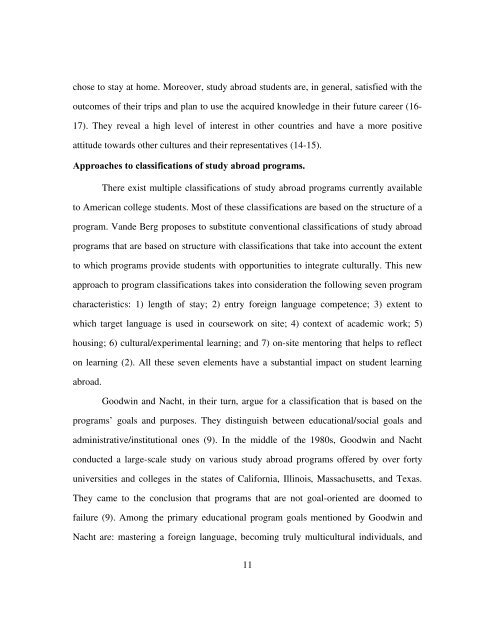Copyright by Tatiana Borisovna Segura 2008 - The University of ...
Copyright by Tatiana Borisovna Segura 2008 - The University of ...
Copyright by Tatiana Borisovna Segura 2008 - The University of ...
Create successful ePaper yourself
Turn your PDF publications into a flip-book with our unique Google optimized e-Paper software.
chose to stay at home. Moreover, study abroad students are, in general, satisfied with the<br />
outcomes <strong>of</strong> their trips and plan to use the acquired knowledge in their future career (16-<br />
17). <strong>The</strong>y reveal a high level <strong>of</strong> interest in other countries and have a more positive<br />
attitude towards other cultures and their representatives (14-15).<br />
Approaches to classifications <strong>of</strong> study abroad programs.<br />
<strong>The</strong>re exist multiple classifications <strong>of</strong> study abroad programs currently available<br />
to American college students. Most <strong>of</strong> these classifications are based on the structure <strong>of</strong> a<br />
program. Vande Berg proposes to substitute conventional classifications <strong>of</strong> study abroad<br />
programs that are based on structure with classifications that take into account the extent<br />
to which programs provide students with opportunities to integrate culturally. This new<br />
approach to program classifications takes into consideration the following seven program<br />
characteristics: 1) length <strong>of</strong> stay; 2) entry foreign language competence; 3) extent to<br />
which target language is used in coursework on site; 4) context <strong>of</strong> academic work; 5)<br />
housing; 6) cultural/experimental learning; and 7) on-site mentoring that helps to reflect<br />
on learning (2). All these seven elements have a substantial impact on student learning<br />
abroad.<br />
Goodwin and Nacht, in their turn, argue for a classification that is based on the<br />
programs’ goals and purposes. <strong>The</strong>y distinguish between educational/social goals and<br />
administrative/institutional ones (9). In the middle <strong>of</strong> the 1980s, Goodwin and Nacht<br />
conducted a large-scale study on various study abroad programs <strong>of</strong>fered <strong>by</strong> over forty<br />
universities and colleges in the states <strong>of</strong> California, Illinois, Massachusetts, and Texas.<br />
<strong>The</strong>y came to the conclusion that programs that are not goal-oriented are doomed to<br />
failure (9). Among the primary educational program goals mentioned <strong>by</strong> Goodwin and<br />
Nacht are: mastering a foreign language, becoming truly multicultural individuals, and<br />
11

















